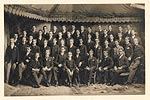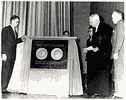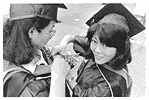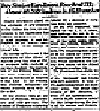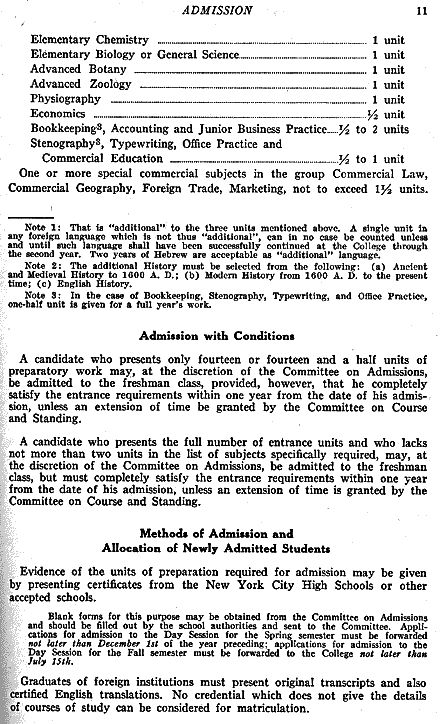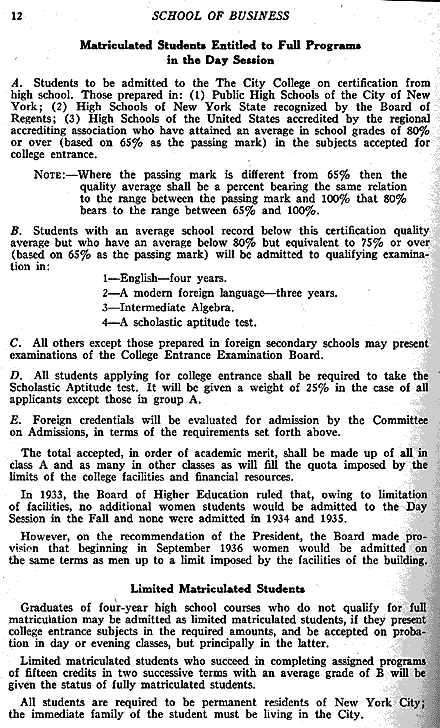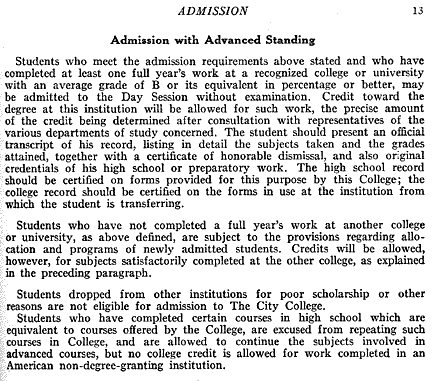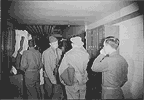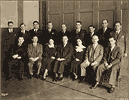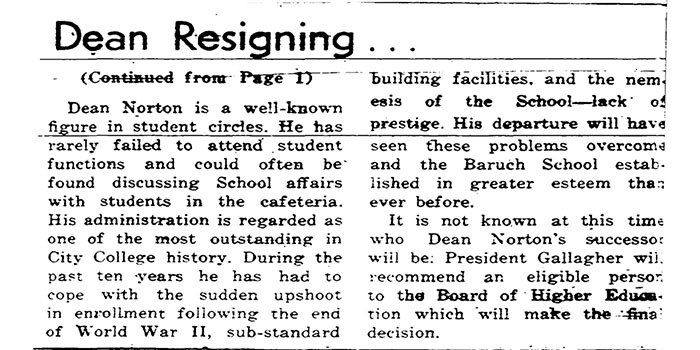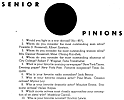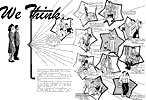History of Baruch College Book and Exhibit
The opening of the new building for the School of Business and Civic Administration in 1929 was a landmark event in business education. “...Provided for [students'] education will, according to the architect, be the 'largest structure anywhere devoted to the teaching of modern business methods.'” [Source: The Campus, September 19, 1929. “College Expansion Reaches Apex with Opening of Business Center and Completion of New Library.”]
By 1935 the demand for higher education in New York City had grown and there was a need for more facilities to meet the educational demands of the populace. At City College, the enrollment in all branches reached an astounding 40,000 students in 1935. Brooklyn College began the construction of a campus that year and by 1937 Queens College had also added a its own facility. [Source: Baruch College Archives. The Ticker, March 11, 1935.]
2.3 “Admission to the School of Business and Civic Administration: Degree of Bachelor of Business Administration”
To matriculate the admission requirements at the School of Business and Civic Administration were high, and to actually complete the degree students were required to take courses in liberal arts as well as business subjects. [Source: Baruch College Archives. The College of the City of New York, The City College Bulletin, 1936-1937.]
The controversy concerning the admission of women to the School of Business was an important topic for the campus newspaper, the Ticker, to highlight on the front page. The President of the School of Business favored the admission of women and discussed the issue in the article. [Source: Baruch College Archives. The Ticker, April 13, 1935.]
It was not until 1930 that women could enroll in day-session courses at the School of Business and Civic Administration. This was a major triumph for women since Hunter College administrators opposed it since the recommendation was first made in the late 1920s. The Board of Higher Education appointed a committee to look into the matter and it was decided to admit women to all technical and professional courses at City College. In addition, the committee took a stand on coeducation when it concluded that women who desire to pursue a business career do not have to be segregated by sex. [Source: Baruch College Archives. Board of Higher Education of the City of New York, Minutes of Proceedings, January 21, 1930.]
Although admitted to the day-session in 1930, the student ratio of women to men remained uneven until the 1940s and the beginning of World War II. Because so many men were serving in the military, the composition of the day-session classes changed dramatically at the School of Business; suddenly, women made up the majority of the student body. This gave women a chance for the first time to take on leadership roles at the college. As reported in the Lexicon: "Another innovation was the discovery that women for the first time held a majority of student offices...as Sadie Rosen assumed the Presidency and Rosalind Klein the secretaryship." [Source: Lexicon, 1944]
The School of Business and Civic Administration joined the other municipal campuses in demonstrating its patriotism. The students mobilized Victory Book Drives, donated blood to the Red Cross, and set up a Department of Military Science, which offered specialized courses to those entering the armed forces. [Source: Baruch College Archives. Lexicon, 1943.]
The Ticker, a student publication which traces its origins to May 7, 1932, has since its inception been a vehicle to inform the college community of activities on campus. During the war years the newspaper covered all war related activities at 17 Lexington Avenue, providing insight into student activities, opinions and responses to the war. [Source: CUNY Matters, December 2002. Sandra Roff, "A WWII Mobilization in the Tale of The Ticker."]
After the war veterans returned to college in record numbers and crowding was a problem. However, this rise in enrollment did not last and by 1948 the number of veterans declined. [Source: American Memory, Library of Congress.]
After World War II, women who had been more daring in career choices during the war years returned to traditional career options such as teaching or secretarial work. [Source: Baruch College Archives. Lexicon, 1943.]
Dr. Harry Wright retired as president of City College in 1952. The proof of his accomplishments lay in successful events and the extensive division of the School of Business. Dr. Wright authored a report about his achievements called "A College Leads, A College Learns: Fruitful Years at City College." [Source: City College Archives. Observation Post, May 21, 1952. Editorial, "Looking Back."]
After World War II, the United States witnessed a rapidly expanding economy. Campuses all over the country saw more interest in the field of economics. At the School of Business and Civic Administration the economics society published a Business Bulletin in the fall of 1947 which contained essays by prominent political and business leaders such as Averill Harriman and Earl Bunting. [Source: Baruch College Archives. Economics Society of the City College of New York, Business Bulletin, School of Business and Civic Administration, Fall 1947.]
The veterans who returned to school following World War II often had families and responsibilities beyond those of a student. [Source: Baruch College Archives. Lexicon, 1949.]
During the war years enrollment dropped at City College and with it came the reduction in the number of faculty members. After the war, with students returning to school new faculty were hired. [Source: Baruch College Archives. The College of the City of New York, Faculty By-Laws, 1946.]
The largest departments in the School of Business and Civic Administration in the 1930s were the accounting and economics departments. Women were already members of the department in 1933. [Source: Baruch College Archives.]
Dr. Thomas Norton was dean of the School of Business and Civic Administration from 1945 until 1955. During his tenure he promoted many faculty members and began new programs. [Source: The Ticker, May 3, 1955. "Norton Resigning to Head NYU School."]
Townsend Harris High School began in 1847 as a sub-freshman year to prepare young men for the Free Academy. The one-year course evolved into a three-year high school program for high achieving students. In 1907 the high school was moved to the new uptown campus where it remained until 1930. In 1930 overcrowding uptown led to the move to the top floors of the City College School of Business building at 17 Lexington Avenue. In 1942 the school lost its funding and it closed. In 1954 a committee was formed to re-establish the school. [Source: The Ticker, September 16, 1954. "Committee Begins Campaign Urging the Early Restoration of HS for Superior Students."]
The rise of Fascism and the threat of war was of concern to both students and faculty in the 1930s. The Ticker kept the School of Business community aware of the antiwar events taking place in the area surrounding the college. [Source: Baruch College Archives. The Ticker, April 8, 1935.]
Cartoons often appeared in the school newspaper the Ticker about the possibility of war. [Source: Baruch College Archives. The Ticker, April 15, 1935.]
The mood of the 23rd Street campus in 1939 was moderate and by 1940 there were no anti-war rallies held on campus. [Source: Baruch College Archives. Lexicon, 1939.]
Similar to the survey above from 1939 (2.20), both the questions and the answers reflect the war-time mood. [Source: Baruch College Archives. Lexicon, 1943.]
